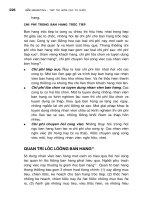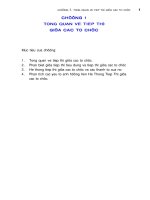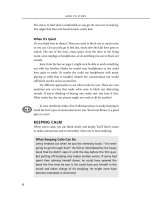How to compete and grow a sector guide to policy phần 5 ppsx
Bạn đang xem bản rút gọn của tài liệu. Xem và tải ngay bản đầy đủ của tài liệu tại đây (2.17 MB, 13 trang )
42
Exhibit 15
The majority of recent attempts to establish local
semiconductor industries or clusters have failed
SOURCE: SEMI World Fab Watch; expert estimates; McKinsey Global Institute analysis
20001980 19901970
United States
$12 billion–$36 billion
Japan
$19 billion–$54 billion
Taiwan
$15 billion–$43 billion
South Korea
$9 billion–$26 billion
Singapore
$5 billion–$16 billion
Germany
$2 billion–$7 billion
Malaysia
$1 billion–$3 billion
China
$6 billion–$17 billion
Successes and failures of semiconductor clusters
Estimated date of industry reaching significant size
1
and
estimated cumulative country-wide government incentives
2
ROUGH ESTIMATES
Present
Currently not present
Sustainable competitive edge
1 Estimated date of industry reaching significant size = first year in which cumulative country-wide database-listed front-end
investments exceeded $1 billion.
2 Estimated cumulative country-wide government incentives to 2008 assumes database underestimates investment in
semiconductor facilities by factor 1.2–2.0; government incentives account for 20–35 percent of total investment.
EXHIBIT 15
Taiwan Semiconductor
Manufacturing Company
(TSMC) first to introduce novel
business model of foundry-only
semiconductor player
Indeed, collectively, large public subsidies have contributed to expanding
production capacity and lowering returns to investment globally, contributing to
intense competition in the sector, rapid innovation, and declining user costs.
52
While semiconductor-using companies and households globally have received
considerable advantages, it is much less clear whether the economic benefits to local
production have justified large public subsidies even in the successful cases.
53
The semiconductor sector case suggests that the way governments can support the
growth of innovative companies depends on the maturity of the sector they are playing
in.
54
In new, eme rgi ng sectors w here there a re no ex istin g playe r s, governm e nts
sh oul d ref rain from def ining the technolo gy o r solutio n of choi ce a s they a re unl ikely to
be able to pick the right one—both the United States and Japan allowed a number of
companies to compete for government financing or contracts. Instead, they should
focus on playing an enabling and possibly coordinating role, creating demand for
early, innovative activities; ensuring that the regulatory environment provides the right
52 Another contributor to the rapid technological innovation in the semiconductor industry has
been the establishment of pooled technology research institutions and other collaborative
efforts nationally and globally. To give just two examples, International Technology Roadmap
for Semiconductors (ITRS) is a consortium of semiconductor companies from all leading
regions collaborating to reduce costs of technology upgrades; and Sematech is a consortium
that focuses on speeding commercialization of technology innovation to manufacturing
solutions through collaboration among semiconductor companies and equipment and
materials suppliers, research institutions, and others.
53 The Japanese policy of favoring local semiconductor suppliers in the 1970s and 1980s helped
sustain the local industry but was not welfare-improving for the nation because of higher
prices to local suppliers. For more detail on the welfare estimates, see Richard E. Baldwin
and Paul R. Krugman, Market access and international competition: A simulation study of 16k
random access memories, NBER working paper 1936, 1986.
54 We cannot transfer all the implications to other R&D-intensive manufacturing sectors:
semiconductor production is exceptionally capital intensive, and some of the winner-takes-all
dynamics resulting from the supply-cost economics would not apply for some other high-tech
segments. This again suggests that understanding the industry dynamics is critical for the
successful design of industrial policy.
43
How to compete and grow: A sector guide to policy
McKinsey Global Institute
incentives for private-sector companies for innovation and growth; ensuring sufficient
flow of research findings; and addressing any standards or coordination issues.
Cleantech is an emerging sector where many governments are looking for ways to
develop a comp etitive l ocal industr y. H oweve r, glob al markets in th is are a are a lready
subject to heavy competition—and not all countries will emerge as winners. What is
certain is that government policies are shaping the global economics of these sectors
and influence who will be the winning companies and regions—the announced
stimulus support globally to these sectors alone exceeds more than $500 billion.
When an industry already exists, there are cases in which government support has
helped local companies catch up with leading incumbents. Yet the odds are against
the ef for t, a nd succe s s requ ire s c har ting a cour se base d on so lid busine s s lo gic, as
TSMC did.
5. MANUFACTURING: AUTOMOTIVE
Manufacturing sectors are among the most frequent targets for proactive
government industrial policy. In the case of the automotive sector, governments
in countries with sufficiently large local markets have on the whole succeeded in
creating local industries. They have done so either by allowing multinational car
companies to establish local production in the country (as in Mexico, Brazil, China,
and South Africa) or by incubating local players by using trade barriers to shield
them from international competition or through additional foreign direct investment
(FDI) barriers (as in India and Malaysia). Yet protection has almost always led to low
productivity and higher costs to consumers.
55
The experi ence of the automoti ve
industry in India suggests that exposing protected firms to global competition can
significantly improve performance (see box 8, “Automotive in India: Protection and
liberalization”).
As well as protection, governments have sought to boost the growth of local auto
sectors through export promotion, establishing state-owned automotive companies,
and the use of more subtle regulatory and demand-management policies to
protect established sectors. In South Korea, Slovakia, and Morocco, for example,
proactive governments have created a growth strategy aimed at fostering a favorable
production environment including incentives to support the creation of an automotive
export cluster. Favorable exchange rates are a factor in the growth performance
of export-oriented automotive sectors in high- and middle-income countries.
E xchan ge rate regimes impact not o nly re lative costs but also locati on decisions—
manufacturers tend to want to hedge currency risk of largely fixed car prices by
locating production within the currency regime of its major sales markets.
Providing incentives for local export promotion can be very expensive. For instance,
Brazilian state governments competing to host new automotive plants offered subsidies
of more than $100,000 for each assembly job created—not unusual sums in comparison
wi th re cent su bsid y l evels elsew here.
56
This l ed both to overcapaci t y and ve r y pre c ario us
financial conditions for Brazilian local governments. The automotive strategy in Malaysia
55 These include, but are not limited to, the cases of the United Kingdom, France, the United
States, Mexico, Brazil, India, Malaysia, and South Africa. MGI has published 12 detailed case
studies on automotive productivity; see www.mckinsey.com/mgi for more detail.
56 For estimates of automotive sector subsidies, see Charles Oman, Policy Competition for
Foreign Direct Investment: A Study of Competition among Governments to Attract FDI,
Development Centre Studies, OECD, 2000.
44
and China has had publicly owned companies competing with private companies—and
public f i r ms in the se t wo c ountr ies have grown to signi f icant s ize. S ome deve lope d
economies have relied on more nuanced policies to protect local industries, ranging from
US tariff protection for the local light-truck segment in the 1990s to “cash-for-clunkers”
policies in Germany and in the United States more recently.
Box 8. Automotive in India: Protection and liberalization
India combined trade barriers to protect its infant automotive sector with a ban
on FDI to encourage the growth of domestic auto companies. This combination
helped to create local industries that generated employment but could not
close the cost and performance gap with global companies. India’s decision to
remove both trade and investment barriers marked the beginning of the sector’s
performance surge. Productivity more than tripled in the 1990s and, as FDI
barriers came down, a significant shake-out in the sector saw some local players
emerge as innovative global competitors (Exhibit 16). With its ultra-low-cost
Nano, Tata has the potential to impact not only demand in developing markets
but also the entire global automotive value chain.
Exhibit 16
Liberalization in India’s automotive sector increased FDI and competition,
leading to significant productivity gains
SOURCE: McKinsey Global Institute analysis
Labor productivity (car equivalents per employee)
Indexed to 100 in 1992–93
1 Actual cars and employment (not adjusted).
2 Hindustan Motors Limited.
38
144
156
354
100
Productivity
in 1992–93
Improvements
at HM
2
Entry of
new players
84
Premier Ltd.
exits
Improvements
at Maruti
Productivity
in 1999–2000
Indirect impact of FDI driven by competition Direct impact
of FDI
Increased automation,
process innovations, and
supplier-related initiatives
drove improvement
Premier Ltd. produced 15,000 cars
and employed 10,000 employees;
Maruti produced 122,000 cars with
4,000 employees in 1992–93
1
Less productive than
Maruti mainly due to
lower scale and utilization
(~75 percent of the gap)
EXHIBIT 16
While government trade regulation and incentives have fundamentally shaped the
evolution of the global automotive industry, competition between governments
to establish or maintain local production has led to large public subsidies being
the industry standard for new plants. This in turn has led to global overcapacity.
Moreover, experience shows that offering incentives alone is not sufficient for
success—a prisoner’s dilemma for policy makers. Being able to attract new players
or grow l ocal ope ratio ns in a se ctor re quires a strong b usiness case too.
How much of this experience in automotive is transferable to other manufacturing?
The automotive sector is at one extreme in terms of the fundamental role that
45
How to compete and grow: A sector guide to policy
McKinsey Global Institute
regulation plays in the industry—but it is by no means unique. US government
tariff exceptions for products with a large US content virtually created Mexican
maquiladoras, manufacturing operations commonly located close to the US border.
However, this US regulation has led to a peculiar structure of border-based enclave
production with limited linkages to the rest of the Mexican economy.
57
As in the c ase
of automoti ve, protecting lo cal produc ers usua lly come s at a cost to co nsu mers.
The high prices and limited growth of the Indian and Brazilian consumer-electronics
sectors can be attributed largely to unintended consequences of policies such as
Brazil’s information act that protected the nascent local computer industry, and
India’s hi gh, yet p oorl y enfo rc e d, n ation al a nd state-level ta r if fs.
58
There is no single right policy to boost growth of manufacturing sectors. However, a
guideline is that the stronger the business case for local production, the easier it is
for industrial policy to succeed. Policy execution, personal passion and drive, and
even luck (for example, whether a local supplier contracts with a growing or declining
auto comp any) all pl ay a par t. All ef fo r ts run the r isk of failing or bein g ver y expens ive
sources of growth. To boost the odds of success, policy should target activities with
real potential for comparative advantage and excellent policy execution.
6. RESOURCE-INTENSIVE INDUSTRIES: STEEL
Steel is a cost-driven, capital-intensive industry where the role of government has
been important. Steel exhibits a clear inverted-U-shaped growth pattern as the
sector moves through increasing income levels—and policy evolves through the
different stages of the sector’s development (Exhibit 17).
Exhibit 17
Steel demand is strongly dependent on growth in
per capita GDP and GDP
SOURCE: J.F. King; World Bank; McKinsey Quarterly; McKinsey Global Institute analysis
1 General steel intensity curve based on findings by Louis Schorsch, published in McKinsey Quarterly.
EXHIBIT 17
Country population
Observed historical
consumption curve
1
0
100
200
300
400
500
600
700
800
900
1,000
1,100
1,200
0 5,000 10,000 15,000 20,000 25,000 30,000 35,000 40,000 45,000 50,000
2007 steel consumption
Kg/capita
2007 GDP at PPP/capita
$
Vietnam
Egypt
Czech Republic
China
Canada
Brazil
Austria
Australia
Argentina
United States
United Kingdom
Ukraine
Turkey
Thailand
Taiwan
Sweden
Spain
South Africa
Saudi Arabia
Russia
Portugal
Poland
Mexico
Korea Republic
Japan
Italy
Iran
India
Greece
Germany
France
Growth economies Inflection economies Mature economies
57 A maquiladora is a factory that imports materials and equipment on a duty-free and tariff-free
basis for assembly or manufacturing and then re-exports the assembled product, usually
back to the originating country. See Diana Farrell, Antonio Puron, and Jaana Remes, “Beyond
cheap labor: Lessons for developing economies,” McKinsey Quarterly, 2005 Number 1.
58 New horizons: Multinational company investment in developing economies, chapter on
consumer electronics, McKinsey Global Institute, October 2003 (www.mckinsey.com/mgi/
reports/pdfs/newhorizons/Consumer.pdf).
46
During the early stages of economic development, demand for steel takes off on
the back of expanding infrastructure and commercial and residential buildings.
Governments consider steel a strategic industry, and public policy often plays a part
in facilitating the steel production take-off.
59
Governm e nts have t y pic a lly helped
finance high industry start-up costs through investing directly in state-owned steel
companies and/or providing loans, land grants, tax holidays, and labor training (we
have seen such approaches in Europe, South Korea, Brazil, India, Turkey, and many
others). Some countries have also chosen to protect emerging local companies
through trade barriers (South Korea, India, and Turkey among them) or explicitly
permitting an oligopoly of steel producers (the most notable example being South
Korea). Although trade protection has helped to incubate local steel industries, it
remains the case that most protected or publicly owned steel industries have lagged
be hind gl oba l be st p ractices and of ten l ed to high loc a l steel price s.
60
China’s steel
industry today is in a rapid growth phase, but China has introduced an innovative way
to take advantage of the large scale of its capacity expansion in the steel sector (see
box 9, “Coordinati ng the sc a ling of Chi na’s steel ind ustr y” ).
Box 9. Coor d i nat i ng the sc a l i ng of C h i na’s steel i ndust r y
Chine se s teel c apa city has ex pand ed g reatly over the pa st decade, a nd the
Chinese economy now consumes more than 40 percent of global steel. This
expansion has allowed China to develop a blueprint for new steel plants that
allows for e c ono mies of sc ale not o nly in th e ir design but also in terms of mate r ials
and construction processes. These factors—together with China’s low labor
costs—have helped to reduce the capital costs of new plants by up to 40 percent
compared with Western standards.
The large scale of the sector has also encouraged the Chinese government to
step up efforts to play a coordinating role in shaping the industry’s development.
For instance, the government has promoted the closure of obsolete capacity and
recently placed a ban on the construction of new greenfield steel plants to avoid a
further build-up of overcapacity.
The government has also encouraged the development of high-value-added
steel production through the use of criteria for project approval as well as through
trade policy. For example, China has introduced export-tax rebates for high-
value-added steel exports, while imposing duties on exports of low-value-added
ste el. In addition, Beij ing is promoting the consolidati on of th e i ndu str y, bu t
prog re s s ha s be e n slow du e to ba r riers suc h a s owne r ship (state vers us prov ince
versus city) and tax considerations.
To ensure efficient, low-cost steel supply for local industries, the Chinese
government has further supported growth in the industry by seeking to reduce
raw materials costs (e.g., through encouraging state-owned enterprises to make
investments overseas), as well as energy and logistics costs, which collectively
represent two-thirds of the overall cost.
59 Because of the low value-to-bulk ratio, particularly in construction-grade long-steel
products, most markets are local or regional. Only 13 percent of global long-steel
consumption is imported.
60 A notable exception to the pattern is South Korea, where heavily protected state-owned
POSCO had a virtual monopoly in the country yet succeeded in reaching global best-practice
productivity in its operations and grew to become a leading global steel company. For more on
the case of South Korea and other protected steel markets including Brazil, Turkey, India, and
Russia, see
47
How to compete and grow: A sector guide to policy
McKinsey Global Institute
Once local industries are established, government attention has tended to shift
toward improving sector competitiveness. Among others, Poland, the Czech
Republic, Turkey, and Brazil have privatized public steel companies and reduced
trade protection, helping raise productivity through consolidation and operational
improvements.
61
The Bra zilia n state of Santa Catalina sou ght to at tract lead ing
global steel companies to produce locally.
62
Others have a imed to cre ate a
favorable environment for the local industry to transition to higher value added flat-
steel products. Examples of this approach include South Korea’s explicit policy
of providing R&D support for new technologies and support for steel-consuming
se ctor s su ch a s a utom otive. Today, both the i ncreasing cost of raw mater ials
an d e n erg y and the downwa rd trend in gl oba l trade barrie rs h as s hif te d the
policy emphasis to improving cost competitiveness through enhancing logistical
ef fe cti ve ness and acc e ss to raw materia ls.
63
As incomes increase, steel industries tend to mature and the role of government has
shifted toward enabling the restructuring and managing declines in employment
through the financial support for job losses. The experience of Europe suggests
that se e k ing to prote ct jobs in in ev i tab ly d e cli nin g se ctor s like steel is ex pensive and
unproductive. Understanding the market imperatives and creating the competitive
incentives for stronger performance, as we have seen in South Korea, has proved
much more ef fe ctive (see b ox 10, “Stee l po lic ies in Eu rope a nd S outh Kore a”).
Box 10. Steel policies in Europe and South Korea
In the late 1970s and early 1980s, the EC responded to plunging European
demand for steel, a halving of employment in the steel sector, and rampant
overcapacity by trying to protect the industry. The EC imposed import restrictions
on up to 80 percent of steel goods, minimum prices for major product categories,
and production quotas based on 1973–74 levels to prevent efficient producers
from gaining market share. Europe nationalized steel companies and supported
them directly through subsidies totaling $40 billion. This was an extraordinarily
expensive strategy, costing an average of $50,000 per steel worker. And it
still failed. The European steel industry remained unviable and teetered into
an othe r cr isis bet we e n 1989 and 19 93. B ut Europ e l e arned its l esson. Instead of
choosing protectionism, policy makers supported the industry’s restructuring,
using public money to help more than half a million displaced workers to retrain
an d f ind wor k in oth er i ndu stries.
South Korea steered its steel industry through both its growth and its inflection
phases. From 1968 to 1973, the government helped companies secure low-cost
and long-term foreign capital, provided discounts on electricity inputs and rail
transport, and limited imports of foreign steel. South Korea set up the Pohang
Iron and Steel Company (POSCO) as a state monopoly and, while continuing to
61 Both Poland and the Czech Republic implemented these changes as a prerequisite to entry
into the EU. For more on Turkey and Brazil, see MGI’s steel case studies at
/>62 The state government of Santa Catalina in Brazil provided tax breaks and land and
infrastructure support for ArcelorMittal’s new steel plants.
63 Iron ore and energy costs have tended upward in the past eight years as extraction has moved
to lower-grade mines where mining costs can be four to six times the cost of lowest-cost
sites. As a result, industry cost advantage has shifted in favor of regions such as Russia where
low raw material and energy costs outweigh the disadvantage of less efficient, older plants.
This illustrates how changes in the global environment can significantly alter the relative cost
positions of commodity-like global industries.
48
give the company financial backing and protecting the domestic market, allowed
POSCO’s management a degree of autonomy to seek inputs, capital, and
knowledge transfer globally. In the late 1980s through 1997, the government leant
indirect support to the sector by promoting steel-intensive domestic industry
but also gradually introduced competition through mandatory price and trade
regulation; productivity started to rise. South Korea finally privatized POSCO,
allowing foreign investors to take equity stakes in the late 1990s. However, even
today the government continues to support the sector through a long-term
commitment to funding R&D, including subsidies for the domestic development
of “original technology,” such as FINEX, which is claimed to be 17 percent more
efficient than blast-furnace technology.
EXECUTION OF POLICY IN CLOSE COLLABORATION WITH THE
PR I VATE SECTOR BOO STS THE ODDS OF SUCCESS
Even after understanding how different kinds of sectors respond to regulation,
there is often no single “right” way to proceed that can guarantee success. Like any
business venture, growth policies are risky, and aspiring practitioners can learn a
great deal from best-practice policy design and implementation in other regions.
Governments then need to make their choices of approach explicit and credible to
the private sector. Businesses also need to keep pace with government thinking.
How policy evolves is v ital for the m. A Decemb e r 2009 McKinsey sur vey found that a
majority of those polled expect government involvement in their industry to increase
over the next three to five years and one-third of them believe that government
policy can impact more than 10 percent of their operating income. Yet a majority
of executives polled were not confident that their companies are effective in their
engagement with government.
64
Experience shows that a high degree of interchange between government and
the private sector boosts the chances of policy success. Government needs to
tap private-sector expertise; businesses need to engage more effectively with
government. Finland’s globally competitive mobile communications sector is
an example of how well public-private collaboration can work. The government
pl aye d a key enab lin g role, bu t i t was th e le ader s hip of h igh-qu a lit y, p rivate -
sector companies in the field that made the running (see box 11, “Public-private
collaboration that made Finland’s IT sector globally competitive”).
64 Andrea Dua, Kerrin Heil, and Jon Wilkins, “How business interacts with government: McKinsey
Global Survey results,” McKinsey Quarterly, January 2010 (www.mckinseyquarterly.com).
49
How to compete and grow: A sector guide to policy
McKinsey Global Institute
Box 11. Public-private collaboration that made Finland’s IT sector
globally competitive
In the 1980s and 1990s, Oulu, a city of 200,000 in Northern Finland, grew into
a significant wireless industry cluster thanks to close collaboration among the
local government, universities, and the private sector—particularly telecom giant
Nokia. All of the stakeholders had a shared mission—to sustain local economic
development and keep Oulu competitive.
With a government defense contract for military radios acting as the initial trigger,
No k ia a nd th e Un iversit y of Oulu for m ed a collab oration to devel op a wirel e ss
communications system for sparsely populated areas. The Oulu initiative not only
kept academic research close to business but also led to policy choices such
as expa nding w ire less engineering educ ation at the ex p ense of other programs.
Wi th th e m unic ipa lit y playin g h ost, ma ny sma ller com panies e merg ed in the same
cluster, which helped create a sustainable pool of talent and expertise.
Government played a crucial enabling role both directly and indirectly. In addition
to the university education and military contracts, the national government
channeled R&D funding to the joint venture through the National Technology
Agency (TEKES)—support that enabled Nokia to continue significant R&D
ef for ts d urin g Finla nd’s deep re c ession i n the early 19 9 0 s. Indirectly, the
regulatory landscape was also an important enabler. The structure of the telecom
operator market, both landline and mobile, consisted of a very large number
of local cooperatives—rather than a single national monopoly as in many other
countries—that helped create dynamic competitive conditions and experiments
with new consumer solutions.
* * *
Designing and implementing policies to improve growth and competitiveness are
not easy. Even if the agenda and the tools are right, poor execution can sink even the
best efforts. The hope must be that, despite today’s challenging market conditions,
governments will learn from the industrial policy missteps of the past. We believe
that taking a sector view and tailoring policy accordingly will boost the odds of policy
changes having a positive impact.
Although today’s business executives are intensely interested in the evolution of
government policy, they need to do more to include policy explicitly in their strategy.
Companies shouldn’t be content with a passive stance toward government
acti vism in the market. T h ey need to aler t po licy m akers to the cha llen ges they fac e
and become thought partners to governments as they seek to calibrate effective
competitiveness policies. The more aligned policies are with business priorities, the
more likely that governments and businesses will both meet their aspirations.
50
Alfaro, Laura, Vinati Dev, and Stephen McIntyre, Foreign Direct Investment and
Ir e l an d’s Tig e r E con omy, Boston: Harvard Business School Publishing, 2005.
Arora, Ashish, and Alfonso Gambardella, The gl o bal i zati o n of th e s of t ware in dustr y:
Perspectives and opportunities for developed and developing countries, NBER
work i ng pape r 10 538, May 2004.
Bahl, Kushe, et al., Wireless unbound: The surprising economic value and untapped
pote ntia l o f t he mo b il e ph one, McK insey & Company and GSM As soci ation,
December 2006.
Baily, Martin N., and Robert M. Solow, “International productivity comparisons
built from the firm level,” Journal of Economic Perspectives, Volume 15, Nu mber 3,
Summer 2001, 151–72.
Baldwin, Richard E., “The impact of the 1986 US-Japan semiconductor agreement,”
Ja pan and th e Worl d E co n omy, Volum e 6, 1994, 129 –52.
Baldwin, Richard E., and Paul R. Krugman, Market access and international
co mp e ti t io n: A s imu lati o n st ud y of 16k r and om ac c e ss me m or i e s, NB ER workin g
pa per 1936, 1986.
Bales, Carter F., et al., “The microeconomics of industry supply,” McKinsey Quarterly,
June 2000.
Barber, Michael, and Mona Mourshed, H ow th e wo r ld’s best-pe r f or m i ng sc hoo l
systems come out on top, McK insey & Comp any, Se ptem ber 20 07.
Beardsley, Scott C., and Diana Farrell, “Regulation that is good for competition,”
McKinsey Quarterly, 20 0 5 Numbe r 2.
Beardsley, Scott C., et al., “Rethinking regulation in emerging telecommunications
markets,” chapter 1.7, The Global Information Technology Report 2007-2008,
World Economic Forum
BSA and IDC Annual Global Software Piracy Studies
( />Buttkereit, Sören, et al., Mob i le bro ad b and for the mass es: Regu l ator y le ve r s to make
it happen, McKin sey & Company, Febr u ar y 20 09.
Carioca, Maria Joao, Rui Diniz, and Bruno Pietracci, “Making Portugal competitive,”
McKinsey Quarterly, 2004 Number 3.
Clark, C. The Conditions of Economic Progress, London: MacMillan, 1940, revised
and reprinted in 1951
Bibliography
51
How to compete and grow: A sector guide to policy
McKinsey Global Institute
Danker, Tony, et al., How can the American government meet its productivity
challenge? McKinsey & Company, July 20 0 6.
Dohrmann, Thomas, and Lenny Mendonca, “Boosting government productivity,”
McKinsey Quarterly, November 20 04.
Dua, Andrea, Kerrin Heil, and Jon Wilkins, “How business interacts with government:
McKinsey Global Survey results,” McKinsey Quarterly, Janua r y 2010.
European Commission, Enterprise and Industry Directorate, European
Competitiveness Report 2008.
Farrell, Diana, Antonio Puron, and Jaana Remes, “Beyond cheap labor: Lessons for
developing economies,” McKinsey Quarterly, 20 0 5 N umbe r 1.
Farrell, Diana, Jaana Remes, and Heiner Schulz, “The truth about foreign direct
investment in emerging markets,” McKinsey Quarterly, 2004 Number 1.
Farrell, Diana, Jaana Remes, and Conor Kehoe, “Service sector productivity:
The tiger’s next challenge,” chapter 2 of Perspectives on Irish Productivity, Fo r fa s,
March 2007.
Fisher, A. G. B., Th e C l as h o f Pr ogr e ss and Se c uri t y, London: MacMillan, 1935.
Fuchs, V. R., The Service Economy, New York and London: Columbia University
Press, 1968.
Harrison, Ann, and Andrés Rodríguez-Clare, “Trade, foreign investment, and
industrial policy for developing countries,” part 14, chapter 63, Handbook of
Development Economics, Volume 5, 2010.
Holbrook, Daniel, “Government support of the semiconductor industry: Diverse
approaches and information flows,” Business and Economic History, Volume 24,
Number 2, Winter 1995.
Irwin, Douglas A., Tr ad e po lit i cs a nd th e s e mi- con ductor in d ustr y, Center for the
Econ omy an d the State, Uni ve r sity of Chi cago, wor k ing pap e r 92, Janua r y 1994.
Jaumotte, Florence, and Nikola Spatafora, “Asia rising: Patterns of economic
development and growth,” chapter III, World Economic Outlook, International
Monetary Fund, September 2006.
Kneip, Thomas, Eric Labaye, and Jürgen Schrader, “Telecom: Advantage France,
Germany,” McKinsey Quarterly, February 2003 (www.mckinseyquarterly.com).
Kongsamut, P., S. Rebelo, and D. Xie, “Beyond balanced growth,” Review of
Economic Studies, 68, 20 01, 869 – 82.
Kuznets, Simon, Mode r n Ec on omi c G r ow th: R ate, S tr u ct ur e a n d S pre ad, New Haven
an d London: Yale Un ive rsit y Press, 1966.
Lewis, William, The Power of Productivity: Wealth, Poverty, and the Threat to Global
Stability, Chicago: Chicago University Press, 2005.
Lovegrove, Nicholas C., et al., “Why is labor productivity in the United Kingdom so
low?” McKinsey Quarterly, 19 98 Numb e r 4.
52
Luzio, E., and S. Greenstein, “Measuring the performance of a protected infant
industry: The case of Brazilian microcomputers,” Review of Economics and Statistics
77, 19 95, 622– 33.
McKinsey Global Institute, A r o ad map fo r E ur ope a n e c o no m ic re for m, August 2005.
McKinsey Global Institute, C ur b i ng gl o bal e ne r g y d e man d g r ow th: T he e ne r g y
productivity opportunity, May 20 07.
McKinsey Global Institute, How IT enables productivity growth, October 20 02.
McKinsey Global Institute, New horizons: Multinational company investment in
developing economies, October 2003.
McKinsey Global Institute, Productivity-led growth for Korea, March 1998.
McKinsey Global Institute, Reaching higher productivity growth in France and
Germany, October 20 02.
McKinsey Global Institute, Sweden’s economic performance, September 1995.
McKinsey Global Institute, Sweden’s economic performance: Recent development,
current priorities, May 20 06.
McKinsey Global Institute, Turkey: Making the productivity and growth breakthrough,
ste e l ca se stu d y, Febr u ar y 20 03.
McKinsey Global Institute, UK productivity report case study: Hotels, Octobe r 1998.
McKinsey Global Institute, U nl o ck in g e c ono mi c gr ow th in R us sia, October 1999.
McKinsey Global Institute, US productivity growth 1995–2000, 2001.
McKinsey Global Institute, Wasted e n e rg y: H ow the Un ited S tates c an re a c h i ts
energy productivity potential, Jun e 2007.
McKinsey Global Institute, W hy the Ja pan e se e con omy is not g ro wi ng: M i c ro ba r r iers
to productivity growth, July 20 0 0.
McKinsey Global Institute and McKinsey & Company, Lean Russia: Sustaining growth
through improved productivity, Apri l 2009.
OECD, The Sources of Economic Growth in OECD countries, 2003.
O’Mahoney, Mary, and Bart van Ark, eds., EU Productivity and Competitiveness:
An Industry Perspective, European Commission, 2003.
Oman, Charles, Po li cy Co mpe ti t ion fo r For e ig n D ire ct Inve stme nt: A S tu d y of
Competition among Governments to Attract FDI, Development Centre Studies,
OECD, 2000.
Pew Charitable Trusts, The Clean Energy Economy: Repowering Jobs, Business, and
Investments Across America, June 20 0 9.
53
How to compete and grow: A sector guide to policy
McKinsey Global Institute
Rodrik, Dani, “Industrial development: Some stylized facts and policy directions,” in
Industrial Development for the 21st Century: Sustainable Development Perspectives,
Department of Economic and Social Affairs, United Nations, 2007.
Sakoh, Katsuro, “Japanese economic success: Industrial policy or free market?”
Cato Journal, Vo lum e 4, Nu mber 2, Fal l 1984.
Schorsch, Louis, and Shinichi Ueyama, “New game, new rules,” McKinsey Quarterly,
May 1993.
Van Ark, Bart, “Sectoral growth accounting and structural change in post-war
Europe,” in B. Van Ark and N. F. R. Crafts, eds., Q u a nt itat ive As p e ct s of Po st-War
European Economic Growth, pp. 84–164, Cambridge, MA: CEPR/Cambridge
University Press.
Weiss, John, Export Growth and Industrial Policy: Lessons from the East Asian
Miracle Experience, ADB Ins ti tute Discus sion Pape r No. 26, Fe b ruar y 20 05.
McKinsey Global Institute
March 2010
Designed by New Media Australia
Copyright © McKinsey & Company
www.mckinsey.com/mgi









